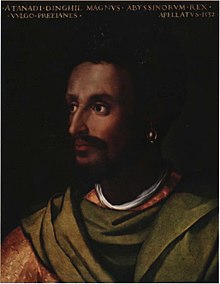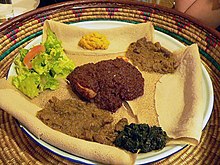The Amhara people (Amharic: አማራ, Āmara; Ge'ez: አምሐራ, ʾÄməḥära) are an ethnic group inhabiting the northern and central highlands of Ethiopia, particularly the Amhara Region. According to the 2007 national census, they numbered 19,867,817 individuals, comprising 26.9% of the country's population. They speak Amharic, an Afro-Asiatic language of the Semitic branch, and are one of the Habesha peoples.
Etymology
The present name for the Amharic language and its speakers comes from the medieval province of Amhara. The latter enclave was located around Lake Tana at the headwaters of the Blue Nile, and included a slightly larger area than Ethiopia's present-day Amhara Region.
The further derivation of the name is debated. Some trace it to amari ("pleasing; beautiful; gracious") or mehare ("gracious"). The Ethiopian historian Getachew Mekonnen Hasen traces it to an ethnic name related to the Himyarites of ancient Yemen. Still others say that it derives from Ge'ez ዓም (ʿam, "people") and ሓራ (h.ara, "free" or "soldier"), although this has been dismissed by scholars such as Donald Levine as a folk etymology.
History
Certain Semitic-speaking peoples, notably the Habesha, built the Kingdom of Aksum around two millennia ago, and this expanded to contain what is now Eritrea and northern Ethiopia, and at times, portions of Yemen and Sudan.
The region now known as "Amhara" in the feudal era was composed of several provinces with greater or less autonomy, which includedGondar, Gojjam, Wollo (Bete Amhara) and Shewa. The traditional homeland of the Amhara people is the central highland plateau of Ethiopia. For over two thousand years they have inhabited this region. Walled by high mountains and cleaved by great gorges, the ancient realm of Abyssinia has been relatively isolated from the influences of the rest of the world. The region is situated at altitudes ranging from roughly 7,000 to 14,000 feet (2,100 to 4,300 meters), and at a 9 o to 14 o latitude north of the equator. The rich volcanic soil combines with a generous rainfall and cool, brisk climate to offer the Amhara a stable agricultural and pastoral existence. However, because the Amhara were an expansionist, militaristic people who ruled their country through a line of emperors, the Amhara people can now be found all over Ethiopia.
Following the end of the ruling Agaw Zagwe dynasty, the Solomonic dynasty governed the Ethiopian Empire for many centuries from the 1270 AD onwards. In the early 15th century, Abyssinia sought to make diplomatic contact with European kingdoms for the first time since Aksumite times. A letter from King Henry IV of England to the Emperor of Abyssinia survives. In 1428, the Emperor Yeshaq sent two emissaries to Alfonso V of Aragon, who sent return emissaries who failed to complete the return trip. The first continuous relations with a European country began in 1508 with Portugal under Emperor Lebna Dengel, who had just inherited the throne from his father.
This proved to be an important development, for when the Empire was subjected to the attacks of the Adal Sultanate General and Imam, Ahmad ibn Ibrahim al-Ghazi (called "Grañ", or "the Left-handed"), Portugal assisted the Ethiopian emperor by sending weapons and four hundred men, who helped his son Gelawdewos defeat Ahmad and re-establish his rule. This Ethiopian–Adal War was also one of the first proxy wars in the region as the Ottoman Empire and Portugal took sides in the conflict.
When Emperor Susenyos I converted to Roman Catholicism in 1624, years of revolt and civil unrest followed resulting in thousands of deaths.The Jesuit missionaries had offended the Orthodox faith of the local Ethiopians, and on 25 June 1632 Susenyos's son, Emperor Fasilides, declared the state religion to again be Ethiopian Orthodox Christianity, and expelled the Jesuit missionaries and other Europeans.
Sometime in the late Middle Ages, the Amharic and Tigrinya languages began to be differentiated. Amhara warlords often competed for dominance of the realm with Tigrayan warlords. While many branches of the Imperial dynasty were from the Amharic speaking area, a substantial amount were from Tigray. The Amharas seemed to gain the upper hand with the accession of the so-called Gondar line of the Imperial dynasty in the beginning of the 17th century. However, it soon lapsed into the semi-anarchic era of Zemene Mesafint ("Era of the Princes"), in which rival warlords fought for power and the Yejju Oromo inderases (or regents) had effective control, while Emperors were just figureheads. The Tigrayans only made a brief return to the throne in the person of Yohannes IV, whose death in 1889 allowed the base to return to the Amharic speaking province of Shewa.
The Amhara have contributed many rulers over the centuries, including Haile Selassie, who was of mixed heritage. Haile Selassie's mother was paternally of Oromo descent and maternally of Gurage heritage, while his father was paternally Oromo and maternally Amhara. He consequently would have been considered Oromo in a patrilineal society, and would have been viewed as Gurage in a matrilineal one. However, in the main, Haile Selassie was regarded as Amhara, his paternal grandmother's royal lineage, through which he was able to ascend to the Imperial throne.
The Amharic language is the official language of Ethiopia. From the time when modern Ethiopia was the realm of Abyssinia, the Amhara and the Tigray filled the ranks of the political elite of the country. Until 1974, most of the Ethiopian emperors were Amhara .
One possible source of confusion stems from the mislabelling of all Amharic speakers as Amhara, and the fact that many people from other ethnic groups have Amharic names. Another is the fact that most Ethiopians can trace their ancestry to multiple ethnic groups. The last Emperor, Haile Selassie, often saw himself a member of the Gurage people on account of his ancestry, and his Empress, Itege Menen Asfaw of Ambassel, was in large part of Oromo descent. The expanded use of Amharic language results mostly from its being the language of the court, and was gradually adopted out of usefulness by many unrelated groups, who then became known as Amhara no matter what their ethnic origin.
Language
The Amhara speak the Amharic language (also known as Amarigna or Amarinya) as a mother tongue. It belongs to the Semitic branch of the Afro-Asiatic family.
Amharic is the working language of the federal authorities of Ethiopia. It was for some time also the language of primary school instruction, but has been replaced in many areas by regional languages such as Oromifa and Tigrinya.
The Amharic language is transcribed using the Ethiopic or Ge'ez script (Fidäl), an abugida.
Religion
The predominant religion of the Amhara for centuries has been Christianity, with the Ethiopian Orthodox Tewahedo Church playing a central role in the culture of the country. According to the 1994 census, 81.5% of the population of the Amhara Region (which is 91.2% Amhara) were Ethiopian Orthodox; 18.1% were Muslim, and 0.1% were Protestant ("P'ent'ay"). The Ethiopian Orthodox Church maintains close links with the Coptic Orthodox Church of Alexandria. Easter and Epiphany are the most important celebrations, marked with services, feasting and dancing. There are also many feast days throughout the year, when only vegetables or fish may be eaten.
Marriages are often arranged, with men marrying in their late teens or early twenties. Traditionally, girls were married as young as 14, but in the 20th century, the minimum age was raised to 18, and this was enforced by the Imperial government. Civil marriages are common, as well as churches. After a church wedding, divorce is frowned upon. Each family hosts a separate wedding feast after the wedding.
Upon childbirth, a priest will visit the family to bless the infant. The mother and child remain in the house for 40 days after birth for physical and emotional strength. The infant will be taken to the church for baptism at 40 days (for boys) or 80 days (for girls).
Culture
Art
Ethiopian art is typified by religious paintings. One of the most notable features of these is the large eyes of the subjects, who are usually biblical figures. Amhara painting is a dominant art form in Ethiopia. It is usually oil on canvas or hide, and it normally involves religious themes. Ethiopian paintings from the Middle Ages are known by art historians from Europe and America as distinct treasures of human civilization. The Amhara are also weavers of beautiful patterns embellished with embroidery. They are fine gold- and silversmiths and produce delicate works of filigree jewelry and religious emblems.
Agriculture
About 90% of the Amhara are rural and make their living through farming, mostly in the Ethiopian highlands. Prior to the 1974 Ethiopian Revolution, absentee landlords maintained strict control over their sharecropping tenants, often allowing them to accumulate cripplingdebt. After 1974, the landlords were replaced by local government officials, who play a similar role.
Barley, corn, millet, wheat, sorghum, and teff, along with beans, peppers, chickpeas, and other vegetables, are the most important crops. In the highlands one crop per year is normal, while in the lowlands two are possible. Cattle, sheep, and goats are also raised.
Main article: Ethiopian cuisine
The Amhara people's cuisine and that of Ethiopian cuisine in general consists of various vegetable or meat side dishes and entrées, usually a wat, or thick stew, served atop injera, a large sourdough flatbread made of teff flour. Kitfo being originated from Gurage is one of the widely accepted and favorite food in Amhara and all over Ethiopia.
Tihlo prepared from roasted barley flour is very popular in Amhara, Agame, and Awlaelo (Tigrai). Traditional Ethiopian cuisine employs nopork or shellfish of any kind, as they are forbidden in the Islamic, Jewish, and Ethiopian Orthodox Christian faiths. It is also very common to eat from the same dish in the center of the table with a group of people.
Validity of ethnic group status
Up until the last quarter of the 20th century, "Amhara" was only used (in the form amariñña) to refer to Amharic, the language, or the medieval province located in Wollo (modern Amhara Region). Still today, most people labeled by outsiders as "Amhara", refer to themselves simply as "Ethiopian", or to their province (e.g. Gojjamé from the province Gojjam). According to Ethiopian ethnographer Donald Levine, "Amharic-speaking Shewans consider themselves closer to non-Amharic-speaking Shewans than to Amharic-speakers from distant regions like Gondar." Amharic-speakers tend to be a "supra-ethnic group" composed of "fused stock".[19] Takkele Taddese describes the Amhara as follows:






No comments:
Post a Comment